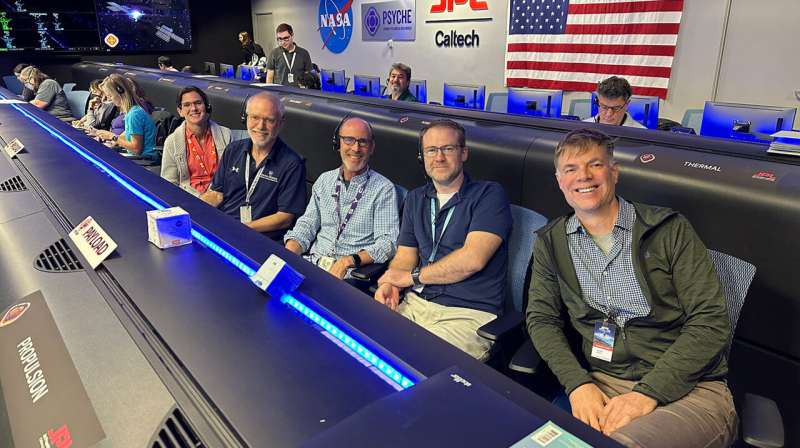The GRS is one half of the Gamma-Ray and Neutron Spectrometer (GRNS) instrument on the Psyche mission.
A subset of the GRS instrument team, consisting of John Goldsten, Patrick Peplowski, Morgan Burks and David Lawrence, watched in awe at NASA's Jet Propulsion Laboratory (JPL) mission operations center in California as "beautiful data" poured down every five seconds from the spacecraft.
The data was collected as part of a highly orchestrated set of activities that have been carefully planned and rehearsed over the past three years. "Our commissioning activities succeeded beyond our expectations, and this success lays the groundwork for future operations during cruise and at asteroid Psyche," said Peplowski, the Psyche GRNS instrument scientist from the Johns Hopkins Applied Physics Laboratory (APL) in Laurel, Maryland. Peplowski led the development of the GRS commissioning activities, in close collaboration with the Psyche science operations team at JPL.
To the untrained eye, the collection of squiggly lines means virtually nothing, but to the multi-institutional team of physicists who spent nine years developing the instrument, those lines are a herald of exciting things to come—for both Psyche and future NASA missions.
"[The data] are showing us that we have a really high-performance instrument, and will allow us to refine calculations about how sensitive we'll be when we get to Psyche," said Lawrence, the Psyche GRS investigation lead, from APL.
Built by APL in partnership with Lawrence Livermore National Laboratory (LLNL) and with significant contributions from Lockheed Martin Advanced Technology Center (ATC), Psyche's GRS will play an important role in the mission's goal to determine whether Psyche—an asteroid 150 miles (240 kilometers) wide—is the fragment of an early planetesimal, or a building block of a planet.
The highlight of the commission measurements, and the key to determining Psyche's composition, are the gamma-ray spectra from the GRS. Like chemical fingerprints, gamma rays released by the interaction of cosmic particles with a planetary surface reveal the elemental composition of that object. Consequently, gamma rays can provide the chemical clues needed to confirm that asteroid Psyche is indeed the metallic remnant of a planetary core from the early solar system.
The Psyche GRS team has built gamma-ray instruments for numerous space missions, including NASA's Near Earth Asteroid Rendezvous (NEAR) mission, which made the first orbital and landed measurements of an asteroid, and NASA's MESSENGER mission to Mercury, both led by APL.
Psyche's GRS incorporates lessons learned from those instruments to advance the state of the art for planetary gamma-ray instrumentation. It employs a new type of cryocooler, developed by Lockheed Martin, to cool the instrument's pure germanium-crystal "heart" to a chilly -292°F (-180°C). "That change should allow the instrument to last significantly longer than its predecessors," Lawrence said.
"It's the highest-resolution gamma-ray spectrometer that has ever flown in space," said Burks, a physicist at LLNL who helped design and build the gamma-ray sensor at the heart of the Psyche GRS. "The data returned already indicate it will have over twice the resolution of our prior MESSENGER instrument, which shows it will have unparalleled sensitivity for measuring the elemental composition of Psyche."
Those auspicious indications bode well not only for what's to come when Psyche reaches its destination in 2029 but also for the coming decades of space exploration. Two upcoming missions will host similar APL-developed GRS instruments, including the MEGANE instrument on the Japan Aerospace Exploration Agency's Martian Moons eXploration mission, and NASA's APL-led Dragonfly mission to Saturn's largest moon Titan. The Mapping Imaging Spectrometer for Europa (MISE) instrument on NASA's Europa Clipper mission uses the same type of cryocooler as the Psyche mission.
After a two-week process of testing the instrument's performance, the team turned the gamma-ray sensor off on Nov. 27. Other portions of the GRS, including a sensor that measures neutrons and protons, remain on. The team is scheduled to turn on the other half of the GRNS—the neutron spectrometer—in mid-December. "Once the neutron spectrometer is commissioned, we'll transition to collecting valuable measurements of the space environment throughout our roughly 5.5-year-long cruise from Earth to our destination in the asteroid belt," Peplowski noted.
Provided by Johns Hopkins University



